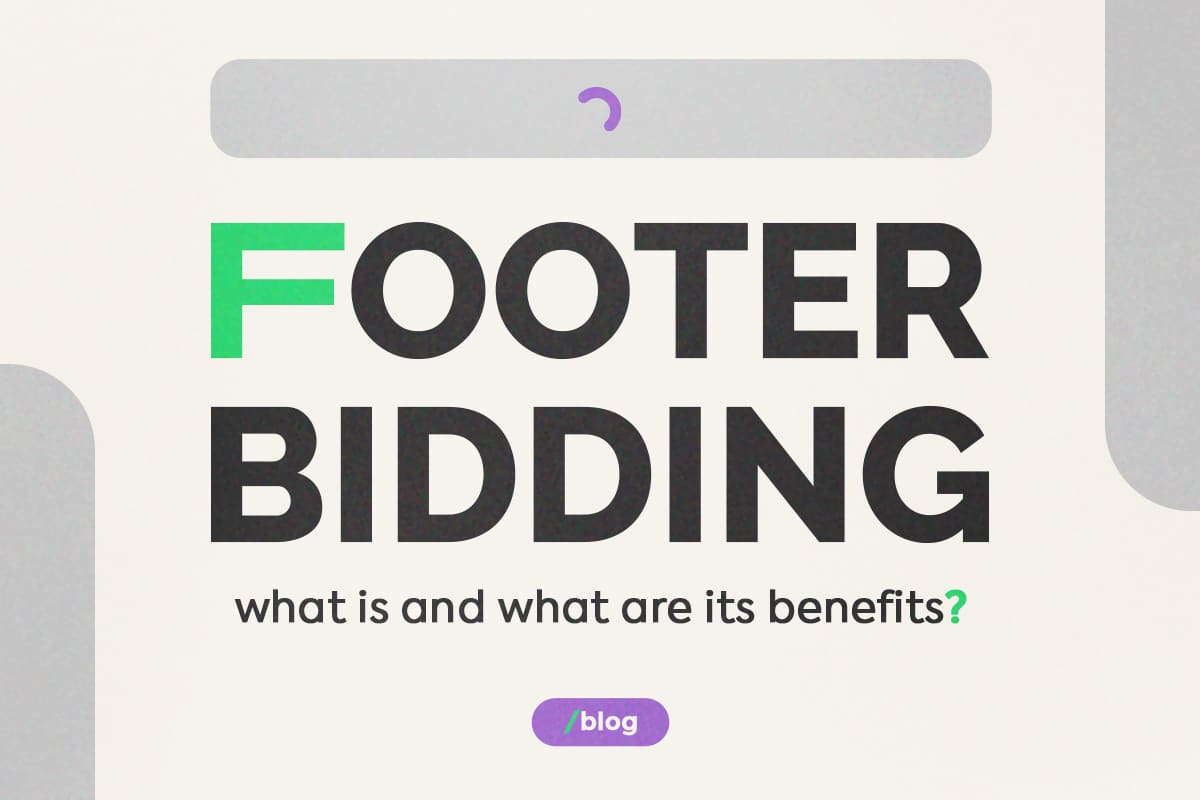In the dynamic domain of digital advertising, publishers consistently seek ways to boost revenue and enhance user experience. A notable strategy in recent years is Footer Bidding, also termed “footer bidding” or “header bidding in the footer.”
Index
Welcome to the Grumft Blog!
If you’re a Grumft advertising partner, welcome! For those not yet affiliated, we hope this article sparks interest in exploring our exclusive programmatic solutions designed for publishers and advertisers. Here, we delve into the concept of Bottom Bid Auction, its mechanics, and the benefits it offers publishers.
Bottom Bid Auction emerged as a solution to address latency and loading speed challenges caused by header bidding. The addition of multiple header bidding partners led to an increase in ad requests, negatively impacting the user experience.
However, implementing Footer Bidding isn’t straightforward. Overcoming latency associated with header bids demands effort and expertise, particularly for publishers with complex ad stacks and diverse ad formats. Bottom Bid Auction bypasses header bid latency by enabling bid requests in the footer of the page.
Despite being a complex and debated topic, Footer Bidding provides a viable alternative for publishers aiming to enhance page loading speed and optimize user experience.
Bottom Bid Auction is a programmatic ad auction technique unfolding at the bottom (footer) of a web page. It empowers publishers to sell their ad spaces to multiple ad networks simultaneously, even before the traditional call to the ad server. This way, all networks get a real-time chance to bid and vie for ad space. Note: Although termed ‘footer bidding,’ the wrapper code is still placed in the site’s header.
In contrast to the sequential ad server method where ad networks are called one after the other, Bottom Bid Auction allows all networks to be called simultaneously. This process unfolds on the client side, parallel to page loading. Networks submit real-time bids, and the highest bid secures the advertising space.
Benefits Galore
Bottom Bid Auction, aka footer auction, unfolds a spectrum of advantages for publishers. Here are some key gains from this monetization strategy:
Revenue Boost
Allowing multiple ad networks to bid simultaneously creates a more competitive environment, resulting in higher bids and increased revenue for publishers.
Enhanced Inventory Fill
Bottom Bid Auction grants access to a diverse array of ad networks, elevating the chances of filling all available ad inventory. This translates to fewer unsold ad spaces and reduced revenue loss.
Granular Control
Publishers gain finer control over ad delivery, prioritizing ad networks, setting minimum bid requirements, and filtering out undesired advertisers.
Improved User Experience
By enabling multiple ad networks to compete, Bottom Bid Auction yields more relevant and higher-quality ads for users, enhancing engagement and lowering bounce rates.
Organic Traffic Surge
Bottom Bid Auction improves page loading speed, resulting in a better user experience and driving an upswing in organic traffic.
Support for CMPs and Tracking Pixels
Bottom Bid Auction ensures proper support for Consent Management Platforms (CMPs) and other tracking pixels, enhancing process efficiency.
Advanced Insights and Analytics
Bottom Bid Auction provides publishers with a comprehensive view of the performance of different ad networks, allowing for in-depth data analysis and valuable insights to further optimize the monetization strategy.
While the concept of footer auctions is thrilling and holds performance potential, its adoption is not yet widespread. However, there’s a success story of a publisher that implemented footer auctions: Ranker.
Ranker successfully integrated footer auctions into its site by bridging its front-end structures with Google Ad Manager, creating a custom wrapper for header bids. This wrapper was designed to await an internal page loading event, triggering ad calls only after the complete loading of all page elements. Learn more about Ranker’s Bottom Bid Auction experience by reading Premesh Purail‘s article on Ranker Engineering’s Medium.
However, it’s crucial to note that implementing footer auctions should not be done on sites already experiencing loading slowness. This can adversely affect ad performance and user experience. Hence, carefully assess the suitability and conditions of the site before considering footer auction implementation.
When contemplating Footer Bidding implementation, it’s essential to evaluate whether potential revenue loss is offset by improved user experience. Advances in Header Bidding implementation have significantly reduced latency, making Footer Bidding a viable option. However, some factors need consideration:
- Ad Placement: Ads above the fold generally outperform those below the fold. Therefore, Footer Bidding might be more suitable when dealing with ad blocks below the fold.
- Site Control: For WordPress sites with limitations in web element customization, implementing Footer Bidding can pose a challenge.
If you still have questions or need assistance in deciding whether Footer Bidding is right for you, our team is available to provide support and guidance.
Final Thoughts
Footer Bidding is an advanced programmatic ad auction technique that opens avenues for publishers to maximize revenue on Google Ad Exchange. With revenue uplift, enhanced inventory fill, refined control, superior user experience, and advanced insights, publishers can seize the opportunity to significantly boost their monetization performance.
However, it’s paramount to emphasize that implementing Footer Bidding demands technical knowledge and proper integration with ad networks. Seeking support from programmatic advertising experts or utilizing technological solutions facilitating Footer Bidding implementation is recommended. In summary,Bottom Bid Auction offers an effective strategy to increase revenue on Google Ad Exchange.
By enabling multiple ad networks to compete in real-time, publishers can secure higher bids, fill more inventory, and exert greater control over ad placements. Additionally, they enhance user experience and gain access to valuable insights for optimizing monetization strategies. When considering Footer Bidding implementation, it’s crucial to evaluate your site’s specific needs, available technical resources, and seek specialized guidance if necessary.
With the right approach and proper configuration, Footer Bidding can be a powerful tool to elevate your revenue on Google Ad Exchange, taking your monetization strategy to new heights. Above all, count on Grumft to support you on this journey.





